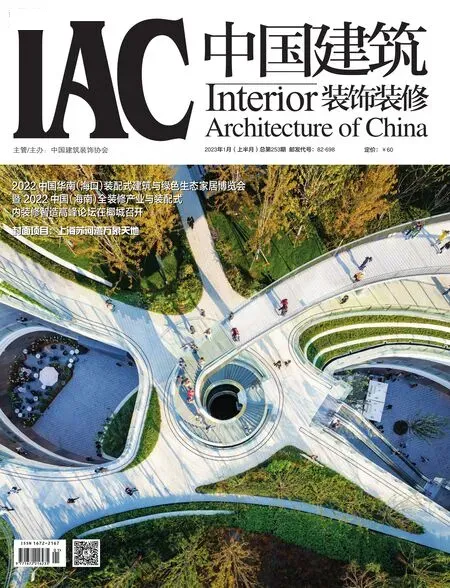以城市绿地打破历史、文化与商业的界限
——上海苏河湾万象天地
责任编辑:张羽
Kokaistudios

Kokaistudios是一家涵盖建筑及室内设计的事务所,在业界屡获殊荣,由意大利建筑师Filippo Gabbiani和Andrea Destefanis于2000年联合创立于威尼斯。自2002年公司总部设于上海以来,Kokaistudios已拥有60余位杰出设计师,并成长为一家多元文化背景的设计公司,与客户协同合作,完成了涵盖亚洲、中东、欧洲及北美洲的众多创新设计项目。Kokaistudios专注于发展文化、商业、酒店及零售等方面的项目,更广泛涉及城市更新与文化遗产再造的项目,旨在为项目所在的城市增添蓬勃生机。

1 俯视苏河湾万象天地的 “洞口”

1 总剖面图
About Kokaistudios
Kokaistudios is an award winning architecture and interior design firm founded in 2000 in Venice by Italian architects Filippo Gabbiani & Andrea Destefanis. Headquartered in Shanghai since 2002 we have grown into multi-cultural firm of 60 people working on a global scale with projects in Asia, the Middle East, Europe and North America. Kokaistudios partners with our clients to collaboratively develop innovative & ground breaking projects in diverse fields of design. Primarily focused on developing cultural,corporate, commercial, hospitality & retail projects we have also worked extensively on urban regeneration projects involving the requalification of heritage locations. Kokaistudios aims to develop projects that add positively to the built environment and social fabric of the cities and countries in which they are located.
Filippo Gabbiani

出生于意大利威尼斯一个艺术家和玻璃制造巨匠辈出的名门,自幼展现出对艺术和设计的多重兴趣。Filippo Gabbiani的事业起步于与其家族合作设计、制作艺术玻璃制品,他毕业于威尼斯建筑大学,其毕业成果是一项由欧共体资助的、关于建筑可替代性能源运用的创新性研究。在遇到合伙人Andrea Destefanis共同创立Kokaistudios之前,Filippo出于本能地对不同学科和多元文化充满好奇心,先后闯荡欧洲数国和美国,曾与数家世界知名的建筑、室内设计和工业设计等领域的事务所合作。在上海成立事务所后,Filippo肩负着Kokaistudios的使命常驻亚洲,致力于可持续性发展建筑的文化推广及亚洲遗迹建筑的保护和修复,并持续着对艺术玻璃设计的研究。
Founder Introduction:
Born in Venice, Italy, from a famous family of artists and glass makers, Filippo Gabbiani developed very early a multidisciplinary interest for art and design. Starting to cooperate with his family in designing and producing artistic glass he completed his studies at University of Architecture of Venice where he graduated with an innovative research sponsored by the European Community on usage of alternative energies in architecture. Following his instinctive curiosity for different disciplines and other cultures he worked in several European countries and in the U.S.A. cooperating with prestigious firms of architecture, interior and industrial design prior to the founding of Kokaistudios.
Andrea Destefanis

出生于意大利都灵的一个舞台艺术之家,很早就培养出了对视觉艺术和舞台布景的浓厚兴趣。在高雅的文化环境中成长并移居威尼斯,在那里完成了其在威尼斯建筑大学的学业后,Andrea 开始了同多个建筑事务所合作的职业生涯,开发了很多获奖的建筑和城市规划项目。受到对不同设计领域的个人兴趣的驱动,Andrea成立了以协同合作为概念的工作室,致力于研究计算机平面设计的创新方法。2000年他遇到了Filippo Gabbiani,由于两人有着共同的建筑理念和对遗迹修护和环境设计的浓厚兴趣,他们开始了深度的合作并最终成立了Kokaistudios,2002年Kokaistudios在上海成立事务所后,Andrea长期移居亚洲,在为事务所努力打拼的同时,继续其对社会和城市环境可持续发展工具的研究和推广。
Andrea Destefanis
Born in Turin, Italy from a family of theater artists, Andrea Destefanis developed very early a strong interest for visual arts and scenography. Growing up in a refined cultural environment he moved to live in Venice where completing his education at University of Architecture of Venice he started to cooperate with several architectural firms and developed award winning projects in architecture and city planning. Moved by his personal interest in different fields of design he founded a co-operative studio focused on research and developing early innovative architectural computer graphic design tools prior to the founding of Kokaistudios.
地点:上海
客户:华润置地、信德集团
服务范围:
上海苏河湾万象天地城市绿地和地下商业空间的总体规划,地下商业建筑设计,
慎余里及天后宫地下商业室内设计,
东北角裙房建筑设计及室内设计。
启幕时间:2022 . 10
占地面积:约5万m2
商业面积:约6万m2
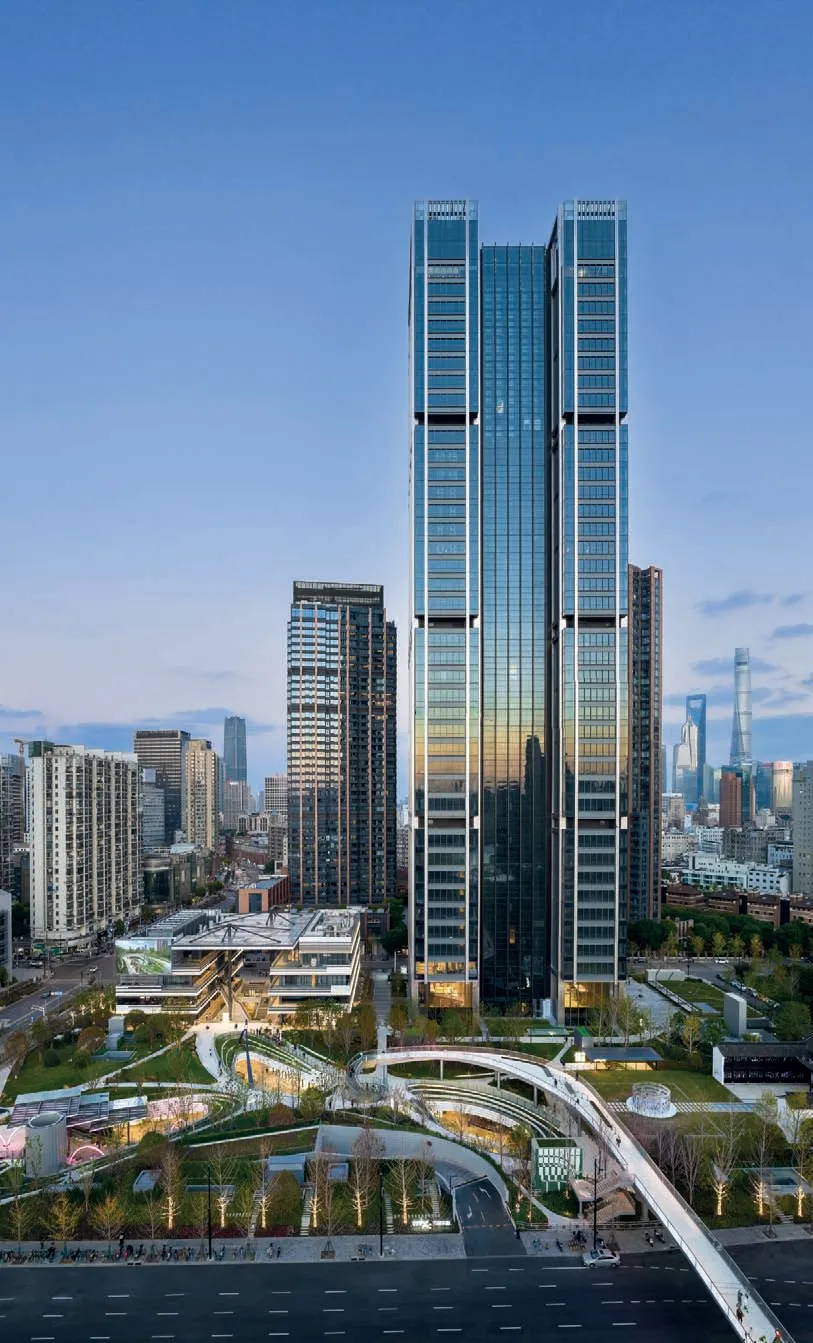
2 一道“天桥”连通项目的东西地块
设计公司:Kokaistudios
首席设计师:Andrea Destefanis、Filippo Gabbiani
建筑设计总监:李伟
建筑设计团队:秦占涛、Eva Maria Paz Taibo、张卫阳子、关博华、Anna-Maria Austerweil、王芮、蒋菁菁、丁乡、王晨昊、李冬吟、许万里、赵青、程子昱、姜新璐、Pietro Peyron
室内设计总监:王思昀
室内设计团队:张丛桑、常青、黄晨宇、谢诚儒、利嘉琪、陈书灏
摄影及视频:张虔希
撰文:Frances Arnold
媒体联络:Jacqueline Chiang
合作设计院:华东建筑设计研究院有限公司
机电顾问:迈进Meinhardt、铂诺客工程咨询(上海)有限公司
结构顾问:奥雅纳
幕墙顾问:阿法建筑设计咨询(上海)有限公司
景观设计(方案): Lab D+H shanghai
景观设计(施工图):上海市园林设计研究总院有限公司
灯光顾问:奥雅纳
艺术品顾问:AllRightsReserved. Limited
艺术展顾问:UCCA Edge
标识顾问:GK Shanghai
写字楼建筑设计、室内设计:Foster + Partners Limited
慎余里保护性修复:上海都市再生实业有限公司
天后宫异地保护:上海交通大学设计研究总院有限公司
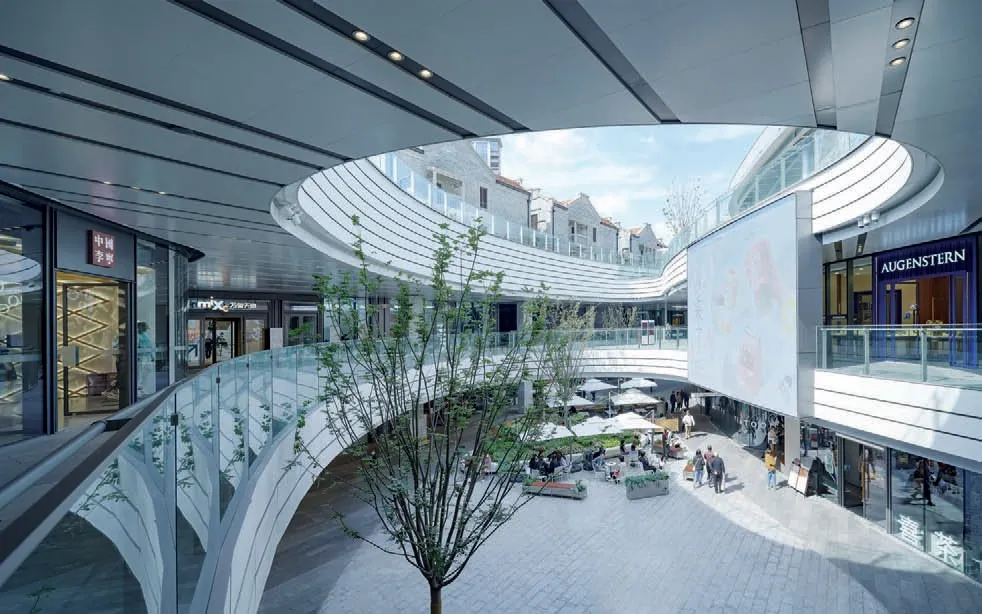
3 地下商业与公共空间之间丰富的层次性
2016年,Kokaistudios应邀参加了位于上海苏河湾绿地地下商业项目的设计竞标。但设计最终呈现出的却不止于商业,而是城中一处全新的公共空间,一个在河畔绿地中聚集了人文和休闲设施的开放性街区。华润置地选择了Kokaistudios建造一座“城市峡谷”—在绿地中打造地下商业空间,并通过一系列阶梯地景式的公共空间设计使其完美融入绿地中。
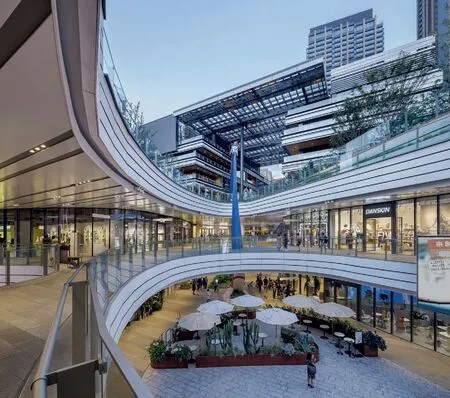
1 艺术装置与项目相结合,带来更多趣味
上海苏河湾万象天地坐落于约4.2万平方米的城市绿地中。按规划设计条件,地面建筑包含保护性修复历史里弄组群“慎余里”,上海历史上唯一一座官制的妈祖庙“天后宫”。由Foster+Partners设计的42层塔楼,是这一区域最高的地标,以及场地东北角新规划的四层门户建筑,二者共同限定了绿地东侧的边界。苏河湾地区的规划开发表明了当地政府计划缝合苏州河两岸,重振苏州河北岸地区的前瞻性眼光,而该区域作为上海过去、现在和未来的交汇点具有极重要的意义。连接苏州河水岸与腹地功能,丰富滨水地区功能复合度和土地集约价值,这也是Kokaistudios设计的切入点。

4 项目中设计了大量的公众座位
基于项目整体设计的思考,Kokaistudios打造了一座“城市峡谷”。两层地下商业空间嵌入“峡谷”之中,“峡谷洞口”的边缘通过层层退台的地景设计与地面绿地相连。除了一座四层新建的入口建筑以外,该项目最重要、最整合性的要素是地面绿地本身。作为令当地居民和来访游客向往的公共空间,绿地的植入为城市中这个曾经被忽视的角落注入了盎然绿意和鲜明的色彩。地面上设置了六个“峡谷洞口”,使公共绿地与商业空间互为风景。洞口的曲线自然流畅,结合满是绿意的台地过渡到商业的共享空间,从而模糊了地上与地下的界限。
场地中央一条城市道路对分了绿地,分置其两侧的鹅卵石形洞口结合地下商业空间的入口。峡谷内伴随商业公共路径上间续组织的绿色种植、公共休息座和咖啡区,唤起过往行人对山谷中起伏的缓坡和梯田式茶园的记忆。东西两组“峡谷”入口的洞口中,侧壁扶梯随地景进入峡谷商业,洞口则同样融入周围景观。从地面绿地中远望,人们只能看到洞口上方的逐级叠落的顶棚,它们暗示了“峡谷”入口的存在。另一个重要的入口则是通过新建的四层裙房进入地下商业空间,巨构尺度的门户限定了绿地与商业。其水平向线条和合宜的建筑材料,将其与塔楼和这片区域开发的建筑群在美学上统一起来。
一座横跨福建北路的人行天桥将项目板块的两部分连接起来。在天桥上能够饱览苏州河两岸壮丽的城市景观,令人心驰神往。天桥也是通往地下商场的主要入口之一,一部垂直梯和与之相邻的开放式旋转楼梯均可将游客直接送达地下商业空间层。
香港创意工作室AllRightsReserved携手德国艺术家IngesIdee创作了两件雕塑作品,进一步洞穿了商业与绿地的峡谷空间:“大象亲子乐团”是两只一大一小的卡通象雕塑相互对望,将地上绿地与地下商业连接起来,以喇叭与低音号为创作元素,其流线形态与洞口的弧度相呼应。另外一件雕塑作品“迈上!”则模仿一个孩子迈着轻快的步伐穿过绿地走向街头,主人公的长腿跨过两层商业峡谷,直到地面上的梯田式地景。艺术作品的创意突出了地面绿地和地下商业空间的穿透性。
购物中心内有两处封闭的室内区域,在空间和视觉上均与苏河湾的重要文化遗产— 慎余里和天后宫相联系。位于正下方的商业空间与地面层的历史遗产,简洁咬合而成,把入口场地空间、轴线和地下公共中庭紧凑对位。Kokaistudios的室内设计团队从传统里弄住宅结构中提取元素,透入天光的玻璃顶窗与轻巧的木椽吊顶相结合,激发历史的哲思,以“商业与遗产对话”的文化特性设计,将保护建筑与商业公共空间完整地结合为空间技术的统一体。
上海苏河湾万象天地是Kokaistudios迄今为止最具创新性的购物中心项目之一。这是一个供人娱乐和放松的城市公共空间,随着移栽树木的茁壮成长,它们将为绿地游客提供舒适宜人的阴凉。在上海这样一个人口稠密的城市,绿地及其关联的城市公共空间对于市民的休闲、健康和保护当地环境的多样性至关重要。
绿地与商业“活力共享、价值双赢”的理念,是基于设计师与政府各个管理部门(绿容、规划、文保、消防等)、业主、商业运营方、工程师充分协作的结果。尤其是峡谷洞口尺度及其形态的确定需要理性测算和动态平衡不同要素,从而最大化城市公共空间、景观环境的综合品质充分优化城市基础设施、设备、疏散等要素的影响。疫情之后的城市,更偏爱以高质量绿色生活为导向构建的场所,这也是未来城市新经济再度生长的珍贵触媒。
上海苏河湾万象天地以“城市峡谷”作为主线的设计概念,离不开城市更新的契机,当城市区域需要建设一个怡人的公共绿地弥补周边社区绿色空间不足时,城市决策者极有前瞻意识地推动了绿地与商业方式的集聚与近邻,通过峡谷商业的公共空间,将绿地和商业有机整合,竖向对位,统一设计和建设,在政府和开发者协力推进下,实现城市市政基础设施、轨交、文保建筑、商办塔楼与公共绿地和商业中心的一体化布置,“投石入水”的触媒涟漪,将带动周边地区的综合更新。Kokaistudios有幸作为主要参与者,见证了这一项目设计赋能的全程。
In 2016, Kokaistudios was invited to participate in a competition for an underground shopping mall in Suhe Creek Green land. Instead, the design opted to present a brand-new public space in the city: a riverside green land with cultural and leisure facilities, incorporating a subterranean commercial area. Property developer CRLand preferred Kokaistudios’ vision for an ‘urban valley,’ the floor of which is a subterranean commercial space that merges into its green land surroundings through a series of stepped slopes.

1 室内空间中选取了古建筑的典型元素
Shanghai Suhe MixC World is located in 42,000 sqm of urban green land. According to the planning and design conditions, its above-ground buildings include the renovated and restored historical lilong group "Shenyu Li”, the only official Thean Hou Temple in downtown Shanghai. The newly planned four-storey gateway building in the northeast corner of the site and a 42-storey tower designed by Foster+Partners, which is the tallest landmark in the area, they together define the eastern boundary of the green land. The new development plan for the Suhe Creek area represents a prospect of the local government's plan to stitch up the two sides of the Suzhou River and revitalize the northern bank, which is an area of great significance as the meeting point of Shanghai's past, present and future. To correlate the waterfront and hinterland functions of Suzhou River, and to enhance the function complexity and intensive use of waterfront area, is the starting point for Kokaistudio’s design.
Taking a holistic approach to the project,Kokaistudio’s vision was that of an urban valley. The commercial space is locatedinside the valley; while its sides take the form of stepped access points. As well as a new 4-floor ‘gateway building,’ the project’s most important and unifying element is the aboveground green land itself. An attractive public space for local residents and visitors alike, it injects welcome greenery and fresh possibilities into this previously overlooked corner of Shanghai.
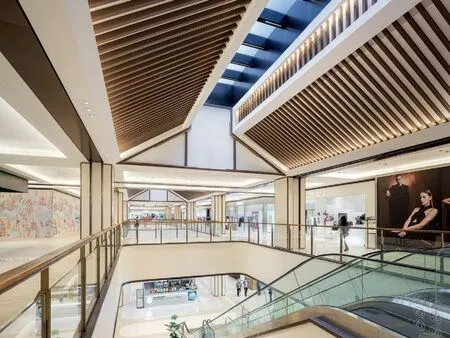
4 室内借鉴了古建筑双坡屋顶的形制
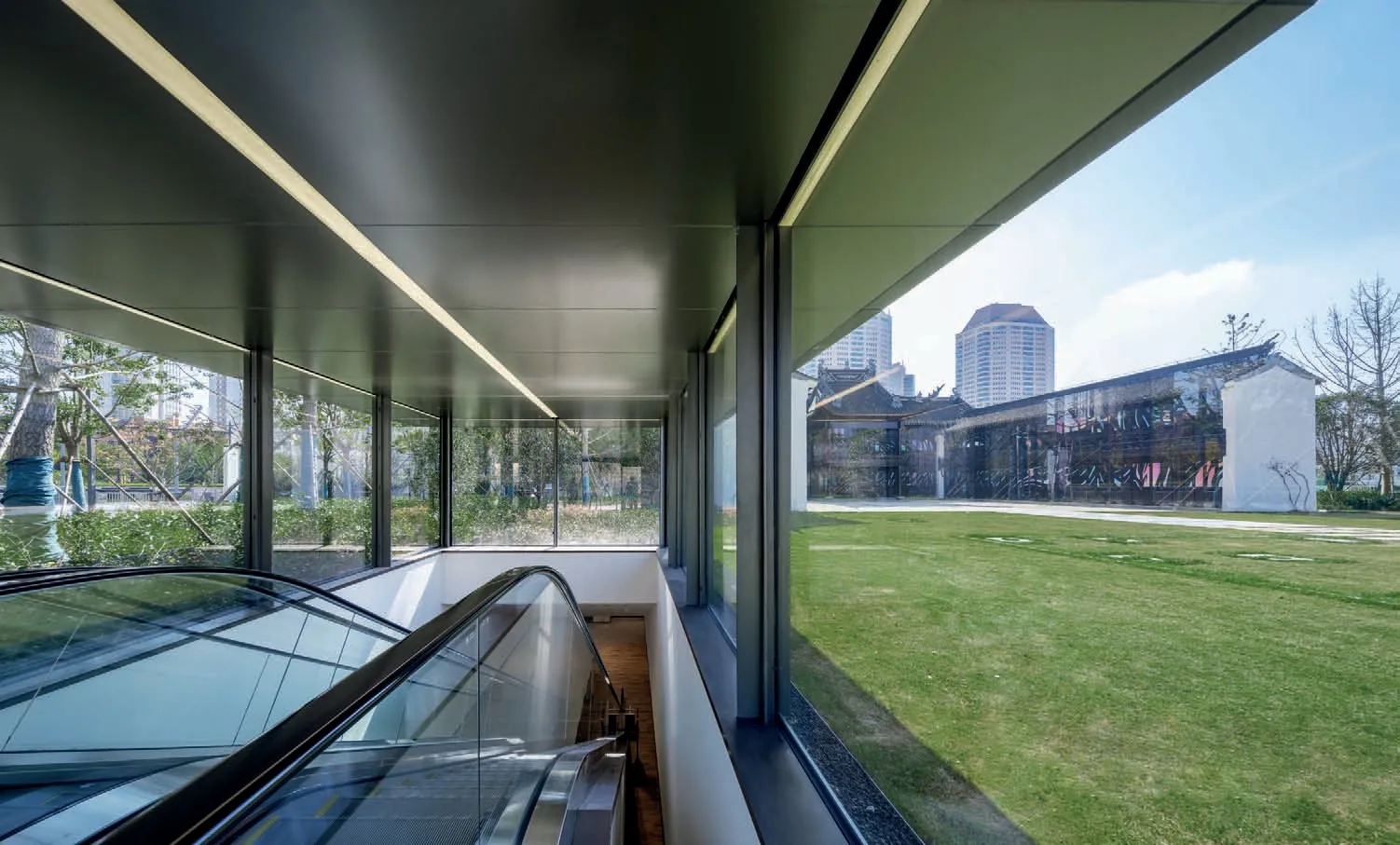
4 入口空间的通透性模糊了内外界限
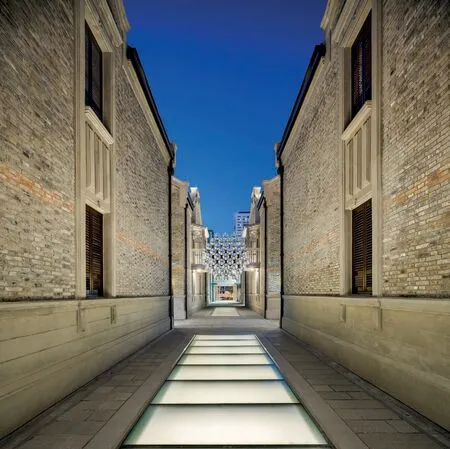
2 地下商业空间天花透出的光线与慎余里建筑相结合
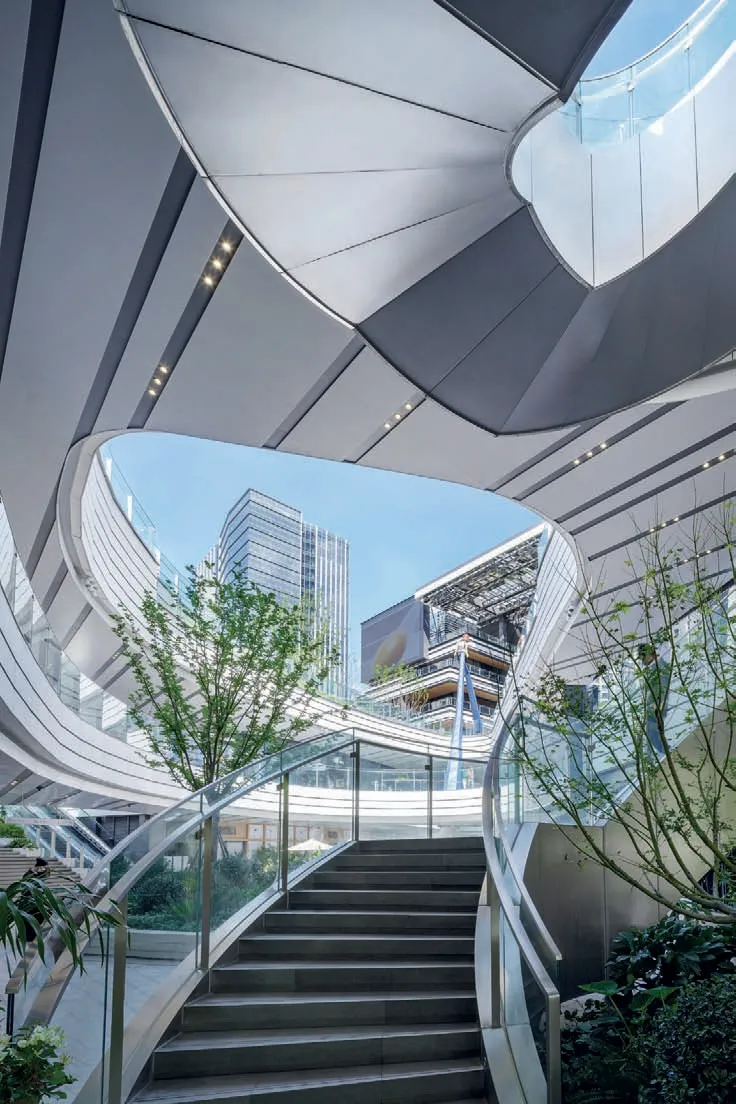
2 从“洞口”仰视

3 卫生间区域色调的一致性

3 与慎余里历史保护建筑的结合
Physical connections between the public green land and commercial space are made visible by six overground openings. Designed to merge with the ground-level green area so as to blur boundaries between above and below,their organic-shape curves incorporate planted steps transitioning down into the space.
The pebble-shaped openings incorporate entrances to the underground commercial space, and are located either side of the bisecting road. Partially planted and with occasional seating areas along their route,as well as coffeeshops, they recall the gentle slopes of a valley or stepped tea fields. With escalators alongside for accessibility, entrances merge with the surrounding landscape, with only their canopies visible from the green land above. Another entrance is via the new fourfloor commercial building. The structure is located next to the office tower, aesthetically uniting the site's recent phases of development through materials.
Physically connecting the site’s two halves is a new footbridge crossing Fujian North Road. The bridge boasts spectacular views across the Suzhou River, making it an attractive vista point for tourists. It is also the location of a primary access point to the mall below. An elevator transports visitors direct to the venues second basement level, and an adjacent open spiral staircase transports shoppers past the mall.
Further linking above and below is a pair of artworks by Hong Kong-based creative studio, AllRightsReserved, and German artist collective, Inges Idee. Family Orchestra, is a giant sculpture of two cartoon elephants gazing at each other, linking the ground-level green land with subterranean commercial area. Their curved the bodies, resembling a trumpet and a tuba, echo the shape of the openings. Striking a similarly playful tone, Up We Go! features a child seemingly mid-stride as he steps through the landscape and out of one of the green land’s openings. The character's elongated legs, which traverse both basement levels to emerge on the terraced slope above,create a connection between above and below.
Inside the mall, two enclosed areas have been designed to physically and visually connect with the site’s significant culture heritage, Shenyu Li and Thean Hou Temple.The commercial space located directly below is succinctly integrated with the historic heritage on the ground floor and compactly locates the entrance, axis and underground public atrium.Kokaistudios' interior design team extracted elements from the structure of the traditional lilong house and apply these to the design.The combination of the glass roof windows and the lightweight wooden rafters ceiling recalled the memory of history. Designed as “a dialogue between commercial and heritage”,they integrate the conservation building with the commercial public space as a spatial technology.
Shanghai Suhe MixC World is one of Kokaistudio’s most innovative shopping mall project. It is a public space for fun and relaxation. As transplanted trees grow, they will provide welcome shade for green land goers’ comfort and enjoyment. In a city as dense as Shanghai, and where a majority of residents do not have access to a private garden, green lands are of vital importance for recreation, wellbeing, and protecting the local environment.
The concept of "shared vitality and win-win value" between green land and commercial is based on the full collaboration among designers and various administrative departments of the government (landscape,planning, cultural protection, fire protection,etc.), the developer, commercial operators and engineers. In particular, the determination of the scale and shape of the “valley” requires rational calculation and dynamic balance of different elements, so as to maximize the comprehensive quality of urban public space and landscape environment, meanwhile to minimize the impact of urban infrastructure,equipment and evacuation route. The cities after the epidemic favor high-quality spaces built with green living in mind, which is also a catalyst for urban economy growth in the future.
The design concept of “Urban Valley”in Shanghai Suhe MixC World is a result of the demand for urban renewal. When this area called for a high-level green land to compensate for the lack of green in the neighborhood, the decision makers are immensely forward-thinking to further the corporation of commercial and green land through this “Urban Valley”. In the joint efforts of the government and the developer,the site is able to house urban infrastructures,metro transportation center, preserved culture heritage, office tower, public green land and commercial space through unified design and construction, which will further lead to comprehensive regeneration of the adjacent areas. Kokaistudios is honored to be one of the key participants in witnessing the design empowerment of this project.

